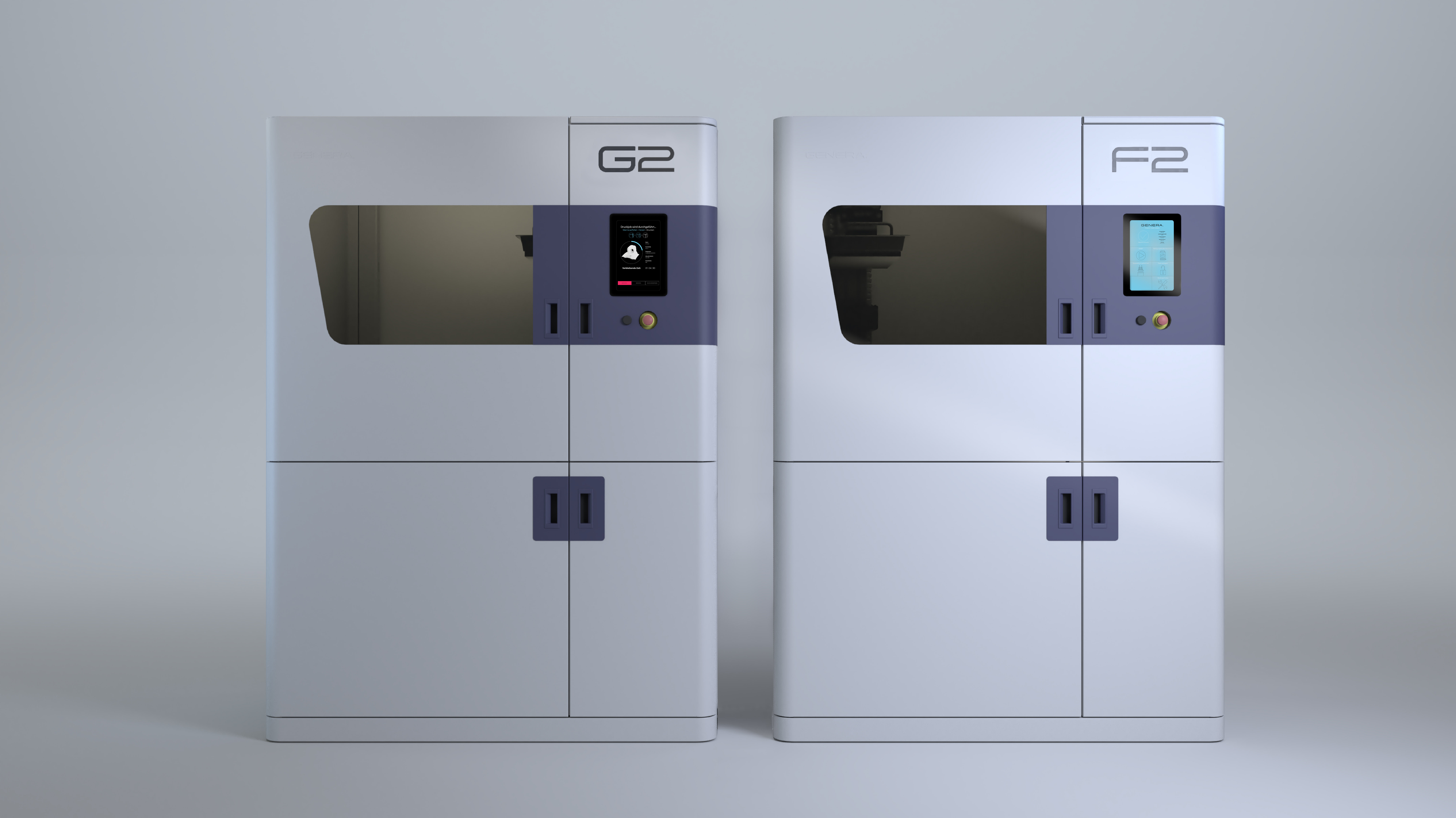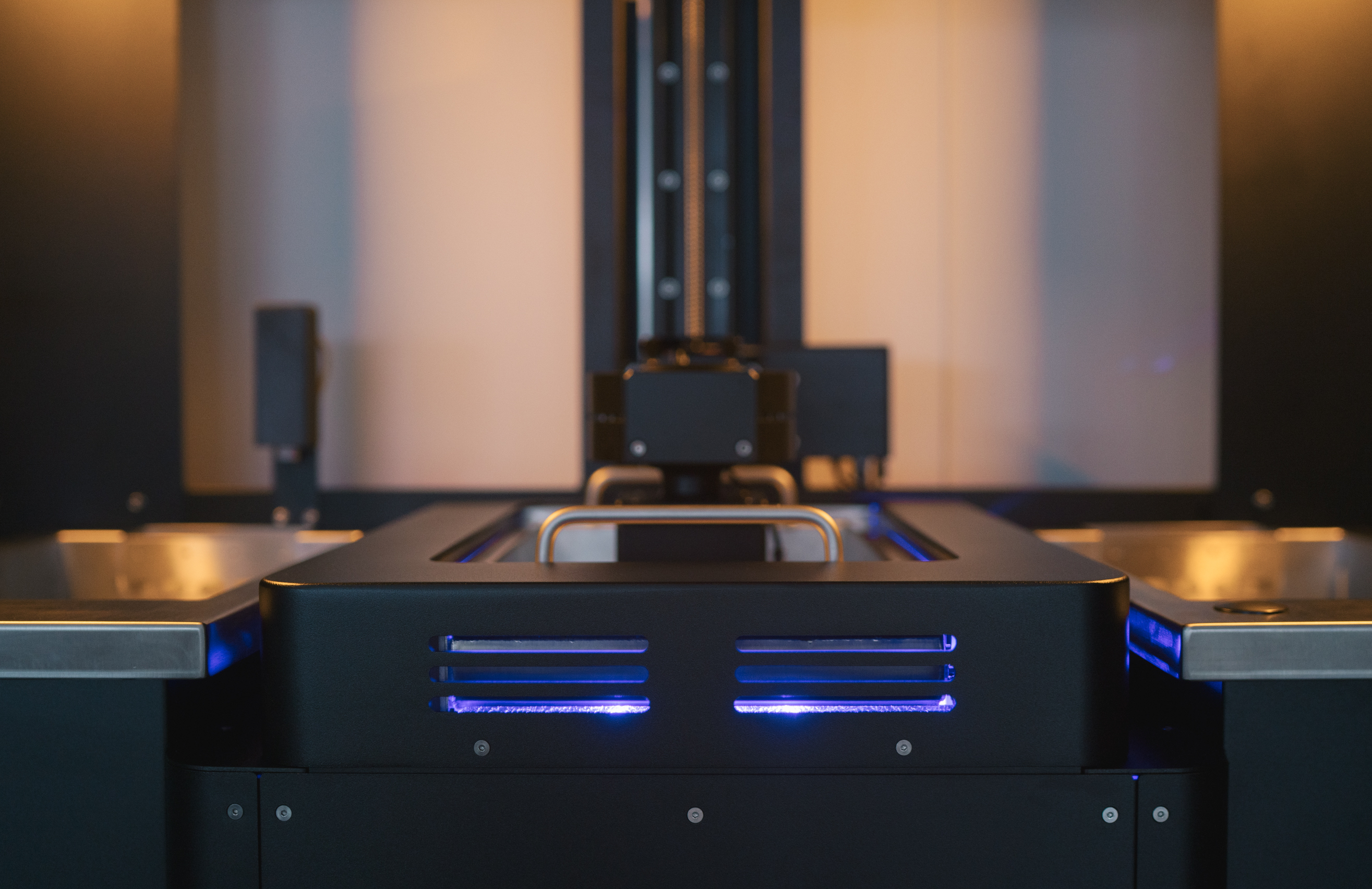“When you look at the story of 3D printing, we think that the industry needs a turnkey solution for the whole process. We don’t want our customers to have to buy five different machines to get the workflow needed to produce their parts, so now we have addressed that issue.”
That’s how Klaus Stadlmann, founder of Austrian 3D printer manufacturer Genera, described the purpose of the company’s upcoming G2 printer and F2 post-processing unit. With the launch of the firm’s inaugural systems now imminent, he and Genera’s Commercial Director Martin Schöppl, spoke to 3D Printing Industry about how their machines enable clients to fully-automate the manufacturing workflow.
“We thought, how can we make something automated like an office printer?,” explained Schöppl. “So we built our system to operate like a Polaroid camera. Using our systems, you can push a button, and get a part printed without needing a separate ‘darkroom’ for post-processing.”
“We have rethought how to optimize the workflow of 3D printing. This could be the future of stereolithography (SLA)”

The “Genera process” and automated 3D printing
Established in Vienna in 2015, Genera’s mission statement revolves around bringing “harmonized, clean and fast production” to 3D printing. According to the company, additive manufacturing has failed to live up to its potential in recent years, and only a comprehensive process from initial setup to final result can make this vision a reality.
With this goal in mind, the firm has set out “the Genera process,” a multi-step technique that ensures harmony and consistency within the 3D printing workflow. Users begin by preparing the STL file within the company’s CAM software, which is then sent to the G2 for printing. The system summarily stores the part in the shuttle (or handling box), and transports it to the F2 for post-processing, without any risk of chemical cross-contamination.
An added benefit of Genera’s patented shuttle technology is that the storage containers are fitted with RFID memory chips, which optimize the process, depending on the part’s end-use application. “Even if you work very cleanly with a normal 3D printer, you will produce a lot of waste and chemical contamination. That’s not really how it should be,” said Stadlmann.
“Our F2 unit can use all the information stored in the shuttle to work out what the material and the resin are, and using that information, it does all of the post-processing steps,” added Stadlmann. “When the process is done, and it is completely automated, you just remove the shuttle and you have parts that are ready to be used.”

Genera’s new 4K DLP 3D printer
Genera’s upcoming printer is a 4K Digital Light Processing system, which has been designed for use by service providers and within production facilities. The G2 comes equipped with a 384 x 216 x 350 mm build volume, which allows users to produce differently-sized parts, depending on the level required for their end-use.
The system features adjustable 4K DLP technology, meaning that clients can change the system’s pixel settings between presets of 40, 70, or 100 microns. Users can also manually configure the machine to print with any detail level from 0-100 microns, which according to Stadlmann, “future-proofs” the printer and makes it compatible with future innovations.
“The larger the pixels size is, the bigger you can print, the smaller the resolution, the more detail you can achieve,” said Stadlmann. “Our system can also do different pixel sizes, so when you buy our machine, you will be future-proofing your business. It’s state of the art technology.”
The G2 has been designed with an open material library too, making it compatible with any photopolymer on the market, once it has been qualified by Genera. Schöppl said that the company is already seeking to collaborate with established chemical partners in the industry, to build up a selection of printable materials for the G2, ready for launch.

“We are not closing the system to our own property or materials, and it’s open to basically every material provider which is available on the market,” explained Schöppl. “We do have to pre-qualify them first, but we’re working with main materials suppliers such as Henkel, BASF, and others to make it happen.”
The wide range of polymers compatible with the G2, along with its data-tracking capabilities, enable it to optimize parts for applications ranging from industrial and automotive use to the medical industry. According to Stadlmann, Genera’s new machine has been built with a focus on healthcare applications because it would be easier to use such a machine to produce industrial parts than vice-versa.
“We track the whole building process and all the data for each layer such as temperature forces, illumination, and intensity,” said Stadlmann. “This is a really important prerequisite for the healthcare industry. Having the documentation for every part that you produce is a real necessity for quality management.”
“Of course we can print industrial parts as well, but if you choose to choose to market just for industrial applications, it can be difficult to evolve the machine to meet medical needs,” he added.
The Genera F2 system and fully-automated 3D printing
The other half of the Genera process, the F2 post-processing system, is being launched alongside the G2, with the aim of providing a complete solution from part design to applying an end-use finish. The F2 is designed to wash and cure 3D printed components using its integrated magnetic stirrer and sensor-controlled, heatable curing chamber.
To further Genera’s goal of automating the printing process, it will be possible to integrate future iterations of Genera’s machines into one unified system. The connected machines enable a fully-optimized workflow by removing the need to manually handle the shuttle between the two machines, turning the G2 and F2 into a production line. Although users won’t be able to combine the systems at launch, Genera has committed to introducing the feature via an update next year, should there be sufficient demand from customers.
“We have connected two machines together to make one out of it,” said Schöppl. “Now users can achieve 100 percent optimization because you don’t have to handle the shuttled manually between the two machines to have a fully-automated system.”
“In the update we have used a robotic arm to pick up the parts from the G2 3D printer directly, and post-process them automatically, so it’s really like a production line,” concluded Schöppl. “It’s included in our machines now, so they’re prepared to be upgraded. If you buy a machine, we will upgrade them. We’ll see in the next year if there is a demand.”
Genera plans to release both its G2 3D printer and F2 post-processing system following launch events on September 22nd in German, and September 24th in English. For more information on the company’s upcoming machines, or to register for the launch events, head to the Genera website.
Automated additive manufacturing solutions
3D printing has long been heralded as a disruptive technology that will replace traditional manufacturing processes by producing parts more quickly and cheaply than its predecessors. A number of automotive and aerospace companies have now turned to ‘factory of the future’ concepts in an attempt to fully-automate their production workflows with this goal in mind.
EOS, Daimler, and Premium AEROTEC partnered to launch their NextGenAM initiative in April 2019, which yielded a digital, fully-automated production line for serial 3D printing. Based in Varel, northwest Germany, the factory focuses on the production of aluminum parts for automotive and aerospace applications.
Automotive manufacturers BMW meanwhile, are working on the German-government backed IDAM project. Working with 12 partner firms, BMW is creating a production line that replicates the entire process chain in order to identify any potential opportunities for automation.
Similarly, BMW’s Polyline program has seen it work with 15 other companies to unified quality assurance methodology. The project’s findings could decrease the amount of digital linking steps required to produce plastic parts, reducing manufacturing costs in the process.
Nominations for the 2020 3D Printing Industry Awards are still open, let us know who is leading the industry now.
The fourth edition of the 3D Printing Industry Awards Trophy Design Competition is now underway. Enter your design for the chance to win a CraftBot Flow 3D printer.
To stay up to date with the latest 3D printing news, don’t forget to subscribe to the 3D Printing Industry newsletter or follow us on Twitter or liking our page on Facebook.
Are you looking for a job in the additive manufacturing industry? Visit 3D Printing Jobs for a selection of roles in the industry.
Featured image shows Genera’s upcoming G2 and F2 machines. Image via Genera.



